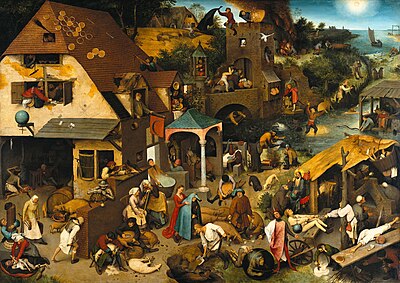| Netherlandish Proverbs | |
|---|---|
 | |
| Artist | Pieter Bruegel the Elder |
| Year | 1559 |
| Medium | Oil-on-panel |
| Dimensions | 117 cm × 163 cm (46 in × 64 in) |
| Location | Gemäldegalerie, Berlin |
Netherlandish Proverbs (Dutch: Nederlandse Spreekwoorden; also called Flemish Proverbs, The Blue Cloak or The Topsy Turvy World) is a 1559 oil-on-oak-panel painting by Pieter Bruegel the Elder that depicts a scene in which humans and, to a lesser extent, animals and objects, offer literal illustrations of Dutch-language proverbs and idioms.
Running themes in Bruegel's paintings that appear in Netherlandish Proverbs are the absurdity, wickedness and foolishness of humans. Its original title, The Blue Cloak or The Folly of the World, indicates that Bruegel's intent was not just to illustrate proverbs, but rather to catalogue human folly. Many of the people depicted show the characteristic blank features that Bruegel used to portray fools.[1]
His son, Pieter Brueghel the Younger, specialised in making copies of his father's work and painted at least 16 copies of Netherlandish Proverbs.[2] Not all versions of the painting, by father or son, show exactly the same proverbs and they also differ in other minor details. The original work by Bruegel the Elder is in the collection of the Gemäldegalerie, Berlin,[3] with the copies in numerous other collections (see below).
- ^ "Pieter Bruegel". APARENCES. Retrieved 11 August 2013.
- ^ Wisse, Jacob. "Pieter Bruegel the Elder (ca. 1525/30–1569)". Heilbrunn Timeline of Art History. Metropolitan Museum of Art. Retrieved 11 August 2013.
- ^ "Die niederländischen Sprichwörter". Staatliche Museen zu Berlin (Berlin State Museums). Retrieved 2024-04-23.